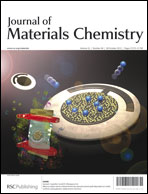Grafting P3HT brushes on GO sheets: distinctive properties of the GO/P3HT composites due to different grafting approaches†
Abstract
In this study, we have grafted poly(3-hexylthiophene) (P3HT) brushes on GO sheets via a silylation reaction of the surfaces of GO sheets and a succeeding “click” reaction (GO(C)/P3HT composite). Compared with pure P3HT and the blend of P3HT and GO, the GO(C)/P3HT composite shows a red-shifted optical absorption maximum because of increased conjugation length of the grafted P3HT, which might be due to the crowding of the P3HT chains grafted on GO sheets. For comparison, P3HT chains were also grafted on GO sheets via the amidation reaction of the carboxylic acid groups (GO(A)/P3HT composite). However, the GO(A)/P3HT composite doesn't show a red shift in the UV-visible spectrum. The overall fluorescence quenching in the GO(C)/P3HT composite includes both dynamic quenching and forming a non-fluorescent ground-state complex. Additionally,


 Please wait while we load your content...
Please wait while we load your content...